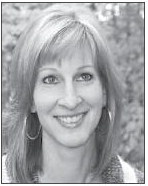Color Blind


On so many spring days, an azalea bush brimming with silky fuchsia blossoms — as bold as Avon lipstick — has taken my breath away. In the summertime, I can’t count the number of times I’ve stopped before a bright blue hydrangea to take in its beauty. Flowers and their colors sing to my eyes and soul — daffodils in the shade of yellow mustard, Shasta daisies that make a field look like a blanket of snow has fallen, and cosmos in palettes of orange and gold that make me think of an Indian sunset.
“Look at that! Just look at that!” I’ve said this to my husband dozens of times throughout the last 34 years of our marriage. He usually glances over, shrugs his shoulders, and replies, “I don’t think I see what you see.”
My husband, Gene, is color blind, a color vision deficiency that makes it difficult for him to distinguish certain shades of green. Moreover, objects that I see as vibrant appear dull to him.
He first realized that he was color blind in his teenage years. “We would all be looking at those color tests where the numbers are hidden within a sea of colored dots [Ishihara Color Tests], and the friends and family members around me would see the numbers, but I could not,” he often recalls. “I thought it was a joke, but I finally realized that I could not discern colors the way others could.”
Throughout our married life, I’ve helped him match his ties with his shirts and his shirts with his pants. He usually does okay on his own, but every now and then, he puts two colors together that clash, and I spend a minute or two explaining why the colors don’t complement each other. He listens somewhat perplexed.
A few years ago, I began seeing videos on television and social media chronicling other people who are color blind looking through special glasses that allow them to see the world as most of us do — in all its colorful, blissful glory. The moment of seeing true color brought many of the people in the video recordings to tears. Perhaps the emotion stemmed from sensory overload, or perhaps the tears were shed because at that moment, the person realizes how much beauty they’ve missed in their lives.
So, for Christmas, I gave Gene some EnChroma sunglasses with patented lens technology designed to expand the range of visible colors he sees. He took the glasses out of their box then wrinkled his brow.
“I want you to see what I see — colors,” I said.
That’s when he understood. He made his way to the front door — a portal to our front yard with fescue grass that is green year round, silvery trunks of oaks and hickories, and newly fallen leaves blanketing the forest’s floor. I took out my phone and prepared to record the big moment.
“No!” he said. “Please don’t record this.”
I slid my phone in my pocket as he lifted the glasses to his face and looked around. It was an overcast winter day with not much color to behold. Still, he looked here and there.
“Are the leaves really that color?” he finally asked. “Are they reddishbrown?”
“Yes,” I answered.
“I’ve always thought they were gray.” He turned his head.
“It really enhances the color, and I think I’m seeing a lot more contrast,” he said. “Over there, the green leaves of that Lenten Rose bush pops out of those reddish-brown leaves. Is that what you always see?”
“Yes.” “And look at that sky…” he said. I won’t pretend to understand continued from page
how the glasses work, but what I know is this: the more he wears the glasses, the more vibrant the colors will become. Somehow, the glasses train the brain to perceive colors more accurately. They filter light to alleviate the red/green color cone sensitivity overlap that leads to color confusion.
Gene wore his glasses as we drove to Chattanooga last weekend, and occasionally pointed to the side of the road and said, “Look at that!” We passed an orange “Construction Ahead,” sign, and he stared at it and said, “That sign is fluorescent orange!”
All I can do is smile and say, “Yes, it is!”
I can’t wait for Gene to wear his glasses this spring, when our flowerbeds erupt with painted peonies, forsythia that the locals call, “yellow bells,” purple wisteria and phlox, and so much more. I can’t wait to stand before them all with Gene, point, and say, “Wow, look at that!”
And for the first time ever, he’ll see what I see.






out of
Posted on